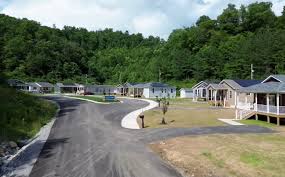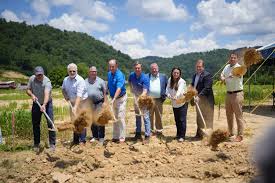
PRESTONSBURG, Ky. — In Eastern Kentucky’s flood-battered hills, the latest groundbreaking for a new neighborhood this week was less a ceremony and more a signal that the region’s slow but determined march toward housing recovery is gaining ground — quite literally.

In Prestonsburg, crews with Frontier Housing, a Morehead-based nonprofit, have already begun trenching footers for the first homes in New Hope Estates, a planned community that will lift dozens of families out of flood-prone areas.
“My crew leaders were talking to the city building inspector as we were leaving, coordinating the inspection of those footers,” said Tom Manning-Beavin, Frontier Housing’s president and CEO. “We’ll pour and just start rocking and rolling.”
The urgency driving Manning-Beavin’s team is shared across Eastern Kentucky’s nonprofit housing sector, where builders have worked at a breakneck pace since catastrophic floods in 2022 destroyed thousands of homes and displaced families from Breathitt County to Knott County. Another round of flooding this February renewed calls for safer, more resilient housing far above the floodplain.
The solution for many is what they call “higher ground” communities — new neighborhoods on safer terrain, sometimes on repurposed strip mines, where families can rebuild lives and find security against future disasters.
In Floyd County alone, the New Hope Estates project will provide 34 homes using federal disaster funding, but builders say that’s just a start.
Scott McReynolds, executive director of the Perry County-based Housing Development Alliance, says the scale of rebuilding has been unlike anything his nonprofit has done in decades.
“We’re producing at a scale that just a few years ago was not conceivable,” McReynolds said. In past years, 20 homes was a “great year” for his team. Now they expect to finish 60 this year, with a target of 140 over two years — still nowhere near enough, he said.

“If that number is even remotely accurate, then we need thousands of affordable units. And even with the flood recovery, we’re building hundreds,” McReynolds said, citing their analysis that about 40% of households in counties like Breathitt, Perry, and Knott live in substandard or unaffordable housing.
The Fahe network, a coalition of more than 50 nonprofits across Appalachia, has embraced the rallying cry “Housing Can’t Wait,” pushing Kentucky lawmakers for more support. Their goal is ambitious: 60,000 homes built or rehabbed across Appalachia by 2030, double their usual pace.
But builders say they can’t do it alone. Many have leaned heavily on federal disaster aid and private donors as they wait for more consistent state investment. A push last year to secure $200 million for Kentucky’s housing trust funds stalled amid skepticism from Republican lawmakers about whether local builders could handle so much funding at once.
On the ground, builders say the proof is visible in places like Thompson Branch, a small hillside community outside Whitesburg, where eight new homes for flood survivors now stand. Seth Long, executive director of HOMES Inc., said some families who moved in had spent years living in cramped trailers after losing everything to the floodwaters.
“When I walked him through the house, which is a modest ranch-style house, he was like, ‘My whole trailer could fit in this one room,’” Long said of one survivor. “He hasn’t been able to move one way or another because there’s nothing that’s available.”
The Thompson Branch homes feature solar panels and energy-efficient designs, critical in a region where utility costs can be crushing. One new resident, Long said, was “tickled to death” to see an electricity bill drop to just $22.58 — a rare relief in Letcher County, where more than 500 households have left flood zones through federal buyouts that haven’t yet been offset with new builds.
HOMES Inc. has bigger plans, with 115 homes envisioned for a new high-ground neighborhood in Jenkins and partnerships with local governments to convert empty schools into rental units. Meanwhile, Frontier Housing is launching a modular home factory in Martin County, hoping to speed up the pace of new builds in multiple communities.
Still, Long warns the region’s recovery is fragile — dependent on federal funds, state investment, and the resolve of local nonprofits working with limited staff and resources.
“This kind of momentum, this kind of investment is what moves the needle. It gives impact. It can get attention. It can house people,” Long said.
Builders say there’s no time to lose, as each heavy rain renews trauma for flood survivors and raises new questions about how best to build for the next generation — in communities that want safe housing but also want to stay connected to the places they call home.
“I think the ‘higher-ground’ communities is great in the sense of if people want to move,” said Courtney Rhoades, an organizer with the Appalachian Citizens’ Law Center in Whitesburg. “You also need to find solutions for people who don’t want to move away.”
Amid federal budget uncertainty, Fahe’s CEO Jim King says nonprofits are turning to private partners to keep building. “I think Eastern Kentucky has spent a lot of time waiting for other people to show up with resources. And that’s — quite honestly — that’s the dynamic I’m actually interested to change,” King said.
For the builders on the ground, each new concrete footer in Prestonsburg or Whitesburg means another family closer to safe, permanent housing — but they’re under no illusions that the job is done.
“We’re just hitting the ground,” Long said. “And there’s so much more to do.”
Originally reported by Liam Niemeyer in News From The States.